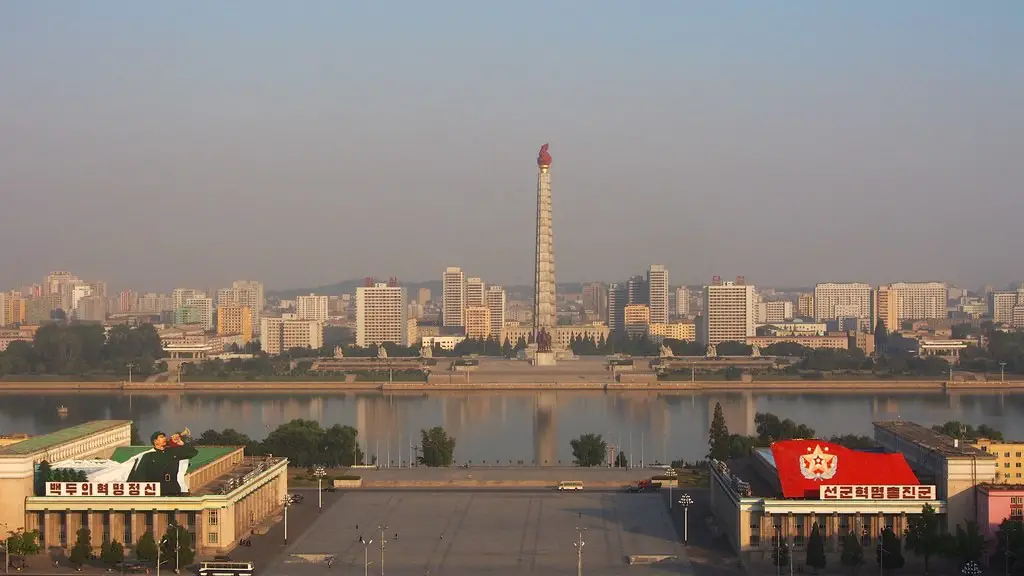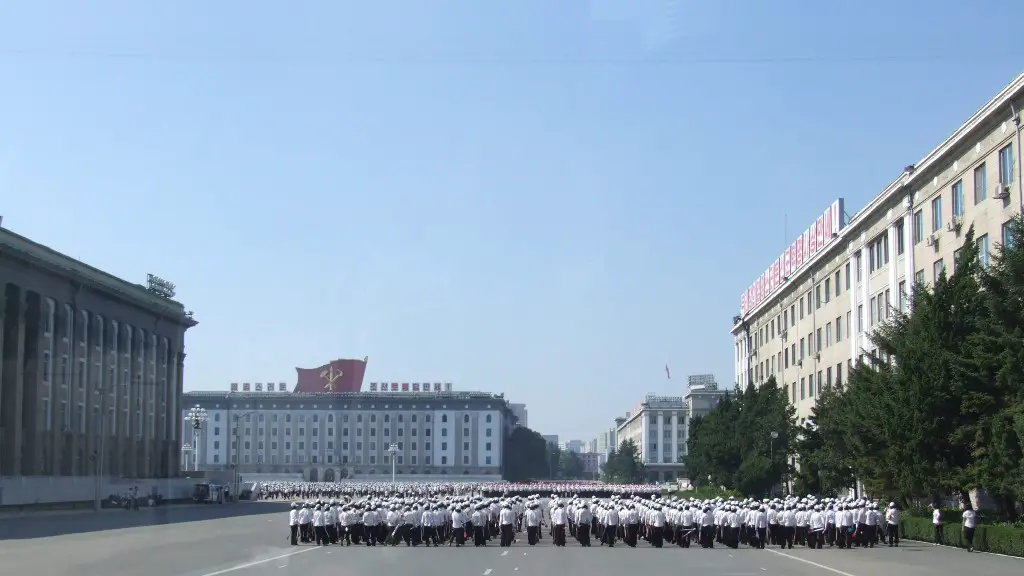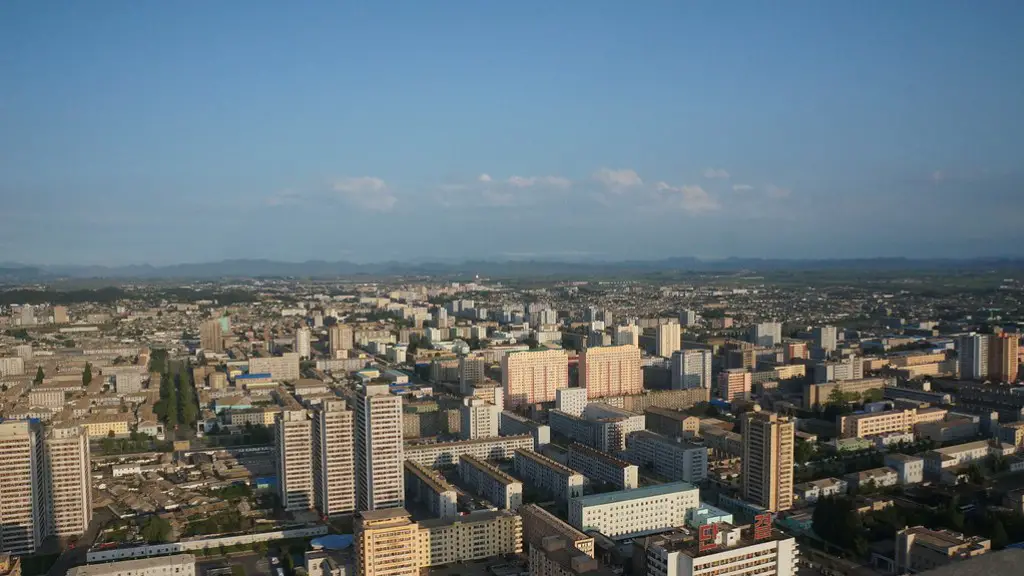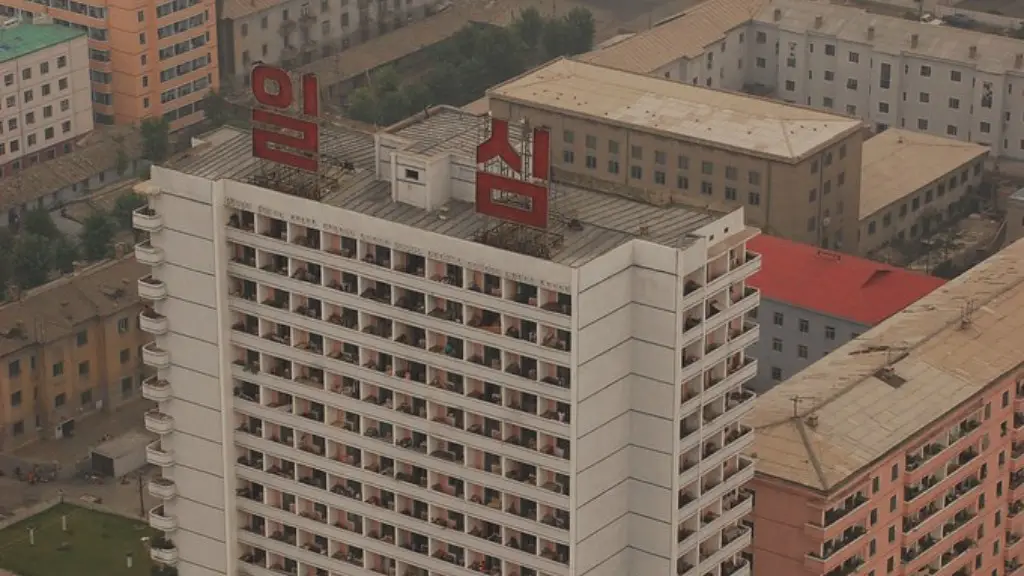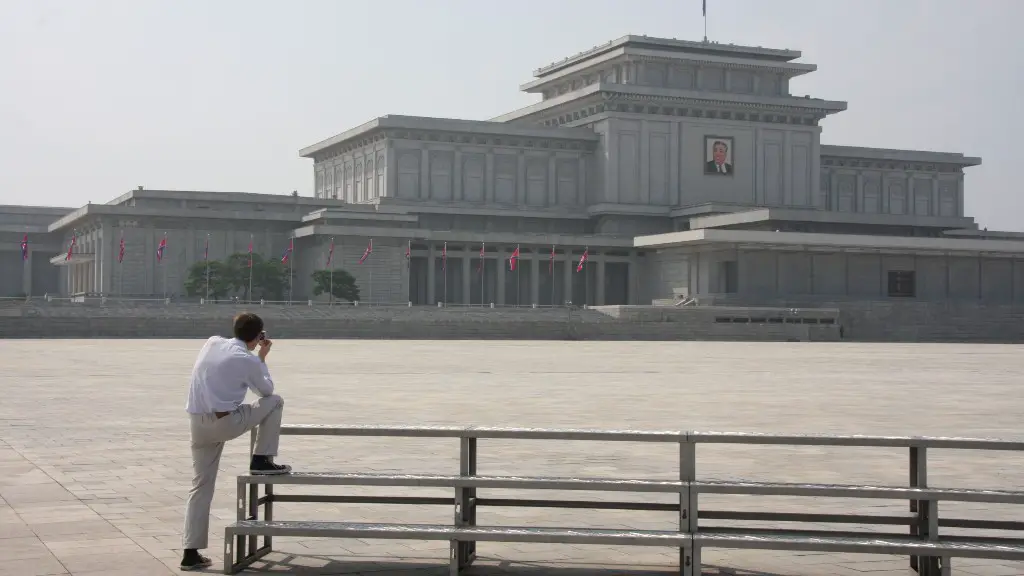The question of who runs North Korea is complex to answer. On one hand, the reclusive state is ruled by Kim Jong Un, the third member of the Kim family to rule the country in its modern-day form. On the other hand, North Korea has a number of powerful institutions and strong leaders, as well as a collective leadership system in place that shapes its policy and provides support for its decisions. So, who really runs North Korea?
To answer this, it is important to examine the power structure of the country. North Korea is considered a one-party state, with the ruling Worker’s Party of Korea (WPK) in charge since 1948. The WPK is led by Kim Jong Un himself and a select group of senior officials. Below, Kim is the Supreme People’s Assembly, the North Korean legislature, which is made up of 687 delegates – mostly from the political elite.
While Kim Jong Un is the face of North Korea, in reality he is a figurehead, who is subject to the restrictions of a highly institutionalized system. His primary role is not to govern, but to act as an enforcer of the WPK policies and ensure that the party remains in power. Real power often lies with a handful of influential individuals in the background. This includes his close advisors, military officials, and members of the influential Workers’ Party Central Committee. Even in the shadow of Kim Jong Un, some of North Korea’s most powerful officials remain in the shadows, the most influential being his sister Kim Yo Jong – an important figure who is by his side during most of his public appearances.
It is these people who are responsible for operating the networks of patron-client relationships which allow this authoritarian system to exist. In short, they operate as a corporate-like entity, providing instructions and resources to ensure that the state’s policies are implemented and executed. However, it is also important to note that it is the general population that ultimately holds the power in North Korea, through their willingness to submit to the authority of the state. This is evident in the recent protests in the country, as well as in elections.
The inner workings of North Korea remain largely hidden from the public, so understanding who truly runs the country is difficult. While Kim Jong Un is officially the leader, it is important to recognize that he is far from the only person in charge. Behind the scenes, an equally powerful system of advisors, bureaucrats, and military leaders are in control of the country. They dictate North Korean policy and control how it is implemented. This is the reality of who truly runs North Korea.
Power Structure
The power structure in North Korea is largely shaped by its historical legacy. During its long history, the country has been governed by a range of political systems, from dynastic rule to centralized dictatorship. Today, the country is led by a single party – the WPK – which holds a monopoly on political power. But beneath this one-party system lies a complicated matrix of networks, patronage, and clientelism – all working together to keep the state afloat and ensure that its policies are enforced.
At the apex of this power structure is Kim Jong Un, who has absolute authority over all decision-making. Beneath him is the Supreme People’s Assembly, a legislature which is comprised of members of the ruling party, as well as other influential officials. Below this is the Workers’ Party Central Committee, which is the ruling party’s main decision-making body. This committee is made up of influential individuals from across the country and oversees the implementation of policy on both the local and national levels.
The real power, however, lies in Kim Jong Un’s close inner circle of advisors – a small group of highly influential individuals who are tasked with carrying out his orders and ensuring the loyalty of the population. These include his sister Kim Yo Jong, military leaders, and senior government officials. This inner circle has significant power over the execution of policy, as they have direct access to Kim Jong Un and can influence his decisions.
In summary, power in North Korea is centralized in the hands of Kim Jong Un and his inner circle of advisors. However, there is also a complex network of networks, patronage, and clientelism that allows this totalitarian system to function.
Military Influence
The military plays an important role in the power structure of North Korea. The Korean People’s Army (KPA) is the country’s main military force and is responsible for protecting the state from external threats. As such, it has become a powerful instrument of the state, with a budget that is larger than the nation’s economy. The KPA also plays an important role in domestic politics, as it is tasked with ensuring the loyalty of the North Korean people and protecting the country from internal threats.
The KPA is under the direct control of Kim Jong Un, who has the power to appoint military leaders and shape the military’s policy. Additionally, the military has a significant amount of influence over the civilian government, as it is responsible for protecting the state and defending its interests. This has led to a wide-ranging system of patronage and reward, where military leaders are given privileged positions and access to resources in return for their loyalty.
Beyond this, the KPA is heavily involved in the country’s economic life. It has a large presence in the economy, and its leaders have considerable influence over the economy, even though they are not formally involved in economic decision-making. This influence can range from investment in key industries to outright control of resources.
Overall, the military has a major role in North Korea’s power structure. It is an important participant in the ruling party’s decision-making process, as well as an influential player in the country’s economy. Its presence ensures that the ruling party is in control and that the state can protect itself from both external and internal threats.
Foreign Relations
Foreign relations are an important part of the power structure of North Korea. The country has a long history of diplomatic relations with a wide range of countries, though it has in recent years become increasingly isolated. The country is especially sensitive to its relations with the United States, which has been a major player in international politics for decades. North Korea’s relationship with the US has been fraught with tensions, and the country remains skeptical of the US’s intentions.
Despite its suspicions, North Korea continues to engage in diplomatic efforts in order to maintain its international presence and secure its interests. It has sought to build relationships with countries such as China, Russia, and South Korea, as well as maintaining ties with its old ally, the Soviet Union. The country has typically seen these relations as a way to gain leverage in the international arena and protect itself from the US.
The country also has a complex relationship with the United Nations. The UN has imposed a series of sanctions on North Korea in an attempt to prevent it from developing nuclear weapons, however, the country has largely ignored these sanctions. This has led to increasing diplomatic tensions between the two and has threatened to escalate further if the situation is not resolved.
North Korea’s relations with the international community have been a major factor in its power structure. Through diplomacy, the country has attempted to gain leverage in international politics and protect its interests from external threats. This has been a major factor in both shaping North Korean policy and ensuring its continued isolation from the rest of the world.
Control of the Media
The media plays an important role in the power structure of North Korea. The country operates a highly censored media environment and tightly controls the news that its citizens receive. All media outlets are strictly regulated by the state and controlled by the ruling party. This is largely due to the government’s paranoia about internal subversion and its fear of external influences, as it seeks to maintain control of public opinion.
The government heavily censors news and forbids any criticism of the state or its leaders. It also controls the flow of information by limiting access to the internet and international media. Additionally, it uses propaganda campaigns to shape public opinion and control public discourse.
The media plays an important role in shaping the public’s perception of North Korea, as it is often the only source of news and information. Through its control of media outlets, the government is able to maintain tight control over the public discourse and spread its preferred narrative. This is an important tool in the government’s power structure, as it allows the state to create a unified and loyal population.
Overall, the media is an important tool for the state in North Korea. Through its control of the media, the government is able to control public opinion and shape the narrative around its actions. This is an important part of the country’s power structure and is essential for maintaining the state’s grip on power.
Economic System
The economy also plays an important role in North Korea’s power structure. The country has a centrally planned economy, where the government controls all economic activities. This includes the production, distribution, and pricing of goods and services. The government also determines which industries will receive financing, who will receive resources, and what products will be produced.
The government is also heavily involved in the economy in other ways. For example, it directly determines wages and employment conditions, and sets prices to ensure that its policies are implemented. Additionally, the government has a heavy influence on the banking sector, as well as the foreign exchange regime. All of this allows the state to control the economy in order to further its own interests.
The economy is an important part of North Korea’s power structure, as it is through control of the economy that the government is able to maintain its grip on power. By manipulating the prices, wages, resources, and investment, the government is able to direct the flow of resources to benefit itself and its allies. This gives the government a powerful tool to maintain its authority and shape public opinion.
Overall, the economy is an important factor in North Korea’s power structure. Through its control of the economy, the government is able to maintain its grip on power and ensure its interests are protected. This is a major part of the state’s power structure, and is an essential tool in its attempts to maintain its control over the country.
